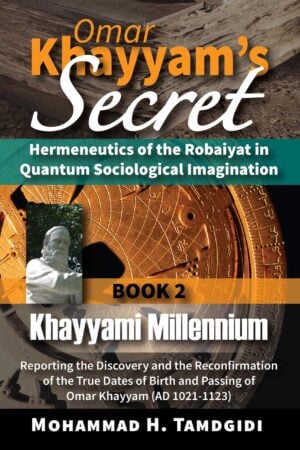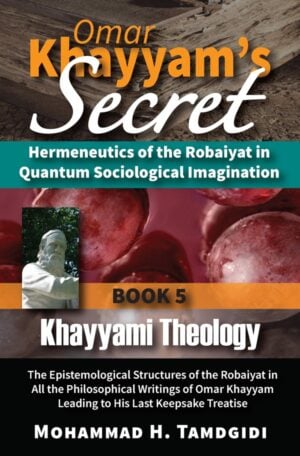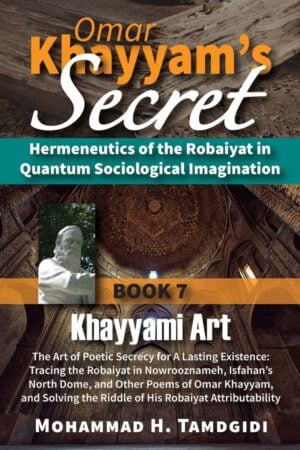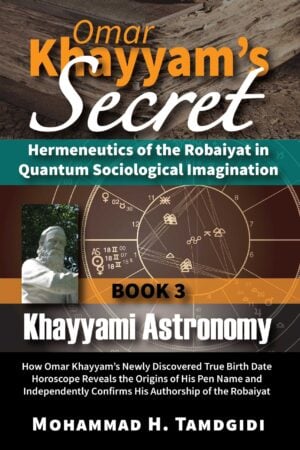Book Section: Preface and the Introduction to Book 4 of “Omar Khayyam’s Secret” Series: The Unique Significance of Omar Khayyam’s Treatise on the Science of the Universals of Existence, His Last Written in Persian for Keepsake — by Mohammad H. Tamdgidi
$20.00
This book section includes the preface and and the introduction essays as described below. The essay titled “Book 4 Preface: Recap From Prior Books of the Series” is the opening, and the essay titled “Introduction to Book 4: The Unique Significance of Omar Khayyam’s Treatise on the Science of the Universals of Existence, His Last Written in Persian for Keepsake,” is the introduction to the book Khayyami Philosophy: The Ontological Structures of the Robaiyat in Omar Khayyam’s Last Written Keepsake Treatise on the Science of the Universals of Existence, which is the fourth volume of the twelve-book series Omar Khayyam’s Secret: Hermeneutics of the Robaiyat in Quantum Sociological Imagination, authored by Mohammad H. Tamdgidi.
Description
Abstract
This book section includes the preface and and the introduction essays as described below.
The essay, titled “Book 4 Preface: Recap From Prior Books of the Series,” is an opening to the book Khayyami Philosophy: The Ontological Structures of the Robaiyat in Omar Khayyam’s Last Written Keepsake Treatise on the Science of the Universals of Existence, which is the fourth volume of the twelve-book series Omar Khayyam’s Secret: Hermeneutics of the Robaiyat in Quantum Sociological Imagination, authored by Mohammad H. Tamdgidi. It offers a summary of prior books of the series.
In the overall series, Tamdgidi shares the results of his research on Omar Khayyam, the enigmatic 11th/12th centuries Persian Muslim sage, philosopher, astronomer, mathematician, physician, writer, and poet from Neyshabour, Iran, whose life and works still remain behind a veil of deep mystery. The purpose of his research has been to find definitive answers to the many puzzles still surrounding Khayyam, especially regarding the existence, nature, and purpose of the Robaiyat in his life and works. To explore the questions posed in the series, he advances a new hermeneutic method of textual analysis, informed by what he calls the quantum sociological imagination, to gather and study all the attributed philosophical, religious, scientific, and literary writings of Khayyam.
In the first book of the series, subtitled New Khayyami Studies: Quantumizing the Newtonian Structures of C. Wright Mills’s Sociological Imagination for A New Hermeneutic Method, following a common preface and introduction to the series, Tamdgidi developed the quantum sociological imagination method framing his hermeneutic study in the series as a whole.
The second book of the series, subtitled Khayyami Millennium: Reporting the Discovery and the Reconfirmation of the True Dates of Birth and Passing of Omar Khayyam (AD 1021-1123), was dedicated to exploring in depth the hitherto findings and controversies surrounding the dates of birth and passing of Omar Khayyam. Therein, Tamdgidi discovered the true dates of birth and passing of Omar Khayyam.
The third book of the series, subtitled Khayyami Astronomy: How the Newly Discovered True Birth Horoscope of Omar Khayyam Reveals the Origins of His Pen Name and Independently Confirms His Authorship of the Robaiyat, was devoted to a close examination of Omar Khayyam’s newly discovered true birth date horoscope, and what information its hermeneutic study can offer for understanding Khayyam’s life and works, especially the origin, nature, and the purpose of his Robaiyat. Therein, Tamdgidi discovered the horoscope origins of Omar Khayyam and independently confirmed his authorship of a collection of robaiyat.
The present volume, the fourth book of the series, is subtitled Khayyami Philosophy: The Ontological Structures of the Robaiyat in Omar Khayyam’s Last Written Keepsake Treatise on the Science of the Universals of Existence. It is devoted to an in-depth and close examination of Omar Khayyam’s treatise “Resaleh dar Elm-e Kolliyat-e Vojood (Treatise on the Science of the Universals of Existence)” which was written originally in Persian for keepsake toward the end of his life.
The essay, titled “Introduction to Book 4: The Unique Significance of Omar Khayyam’s Treatise on the Science of the Universals of Existence, His Last Written in Persian for Keepsake,” is the introduction to Khayyami Philosophy: The Ontological Structures of the Robaiyat in Omar Khayyam’s Last Written Keepsake Treatise on the Science of the Universals of Existence, which is the fourth volume of the twelve-book series Omar Khayyam’s Secret: Hermeneutics of the Robaiyat in Quantum Sociological Imagination, authored by Mohammad H. Tamdgidi.
Tamdgidi states that in this Book 4 and the three more books to follow in this series, he will study the nature of Khayyam’s robaiyat not directly by studying any quatrain(s) themselves, but indirectly, by way of hermeneutic analysis of all other writings more or less authentically attributed to Omar Khayyam, be they philosophical, religious, scientific, or literary.
He notes that in his analysis of the text he will be proceeding with the assumption, following the framework of the quantum sociological imagination method introduced in the first book of the series, that had Khayyam written any quatrains, his mental products would have existed at once, simultaneously, in two folds, one localized in each quatrain’s four lines, and another as spread-out throughout his worldview as expressed in his writings as a whole, including the substance of the treatise under consideration in this book. So, without even analyzing any quatrain directly, we can explore the ontological wave structures of which any quatrain may have been at once a congealed, corpuscular, expression.
In this introduction, the author explains why it is important to begin a hermeneutic study of Omar Khayyam’s writings with the study of his treatise on the universals of existence, which is the focus of Book 4 of the series. The manuscript generally known as Resaleh dar Kolliyat-e Vojood (Treatise on the Universals of Existence), or Resaleh dar Elm-e Kolliyat-e Vojood (Treatise on the Science of the Universals of Existence) (رساله در كليات وجود or رساله در علم كليات وجود وجود), originally written in Persian by Omar Khayyam, occupies a central place in what precious little remains has reached us from him. The most important reasons for the unique significance of this text are in the author’s view the following.
First, as it is apparent from its title, in this short treatise, in his characteristically synoptic way, Khayyam basically offers in a nutshell his view of existence in general. Second, Khayyam himself introduces this treatise by stating that it was written by invitation as a keepsake for his posterity, adding confidently that he hoped scholars would judge it to be “more useful than,” or (depending on one variation of the text) “a condensation of,” volumes. Third, from the name(s) of its addressee, it can be firmly inferred that this tract was written during the senior years of Khayyam’s life, reflecting his most mature viewpoints. Fourth, although some passages of the manuscript seem to have been lost, or survived illegibly, what has survived contains sufficient material for offering us a reasonably clear insight into the basic structure of the senior Khayyam’s worldview—depending, of course, on the extent to which we succeed in hermeneutically penetrating its seemingly brief, yet condensed, layers. Fifth, this treatise is the only known philosophical writing from Khayyam that was written in his native Persian language, which may point to important considerations regarding the specific audience Khayyam had in mind when writing the treatise and the socio-political context in which it was written.
And, sixth, and most importantly in terms of its substance, there is something strange about this treatise in the context of what has been often customarily reported about Khayyam’s views in association with some of his attributed Robaiyat. Contrary to the prevalent views that Khayyam lived a life of puzzlement, dying not having found answers to much of the existential questions he posed in some of the extant Robaiyat, this treatise tells of a Khayyam who seems to have confidently found answers to such questions, as far as human existence is concerned. Tamdgidi argues that any perceived contradiction between Khayyam’s philosophical writings and his attributed poetry does not have to immediately lead us to rushed judgments embracing “two Khayyams” or “two-faced (duplicitous) Khayyam” explanatory strategies, but other explanatory models such as pedagogical presentation needs can also be considered, to which he will return in the course of his hermeneutic analysis of the text in this book and series.
The author ends the introduction by presenting the chapter organization of this book.
Recommended Citation
Tamdgidi, Mohammad H. 2021. “Preface and the Introduction to Book 4 of “Omar Khayyam’s Secret” Series: The Unique Significance of Omar Khayyam’s Treatise on the Science of the Universals of Existence, His Last Written in Persian for Keepsake.” Pp. 1-16 in Omar Khayyam’s Secret: Hermeneutics of the Robaiyat in Quantum Sociological Imagination: Book 4: Khayyami Philosophy: The Ontological Structures of the Robaiyat in Omar Khayyam’s Last Written Keepsake Treatise on the Science of the Universals of Existence. (Human Architecture: Journal of the Sociology of Self-Knowledge: Vol. XVII, 2021. Tayyebeh Series in East-West Research and Translation.) Belmont, MA: Okcir Press.
Where to Purchase Complete Book: The various editions of the volume of which this Book Section is a part can be ordered from the Okcir Store and all major online bookstores worldwide (such as Amazon, Barnes&Noble, Google Play, and others).
Read the Above Publication Online
To read the above publication online, you need to be logged in as an OKCIR Library member with a valid access. In that case just click on the large PDF icon below to access the publication. Make sure you refresh your browser page after logging in.








